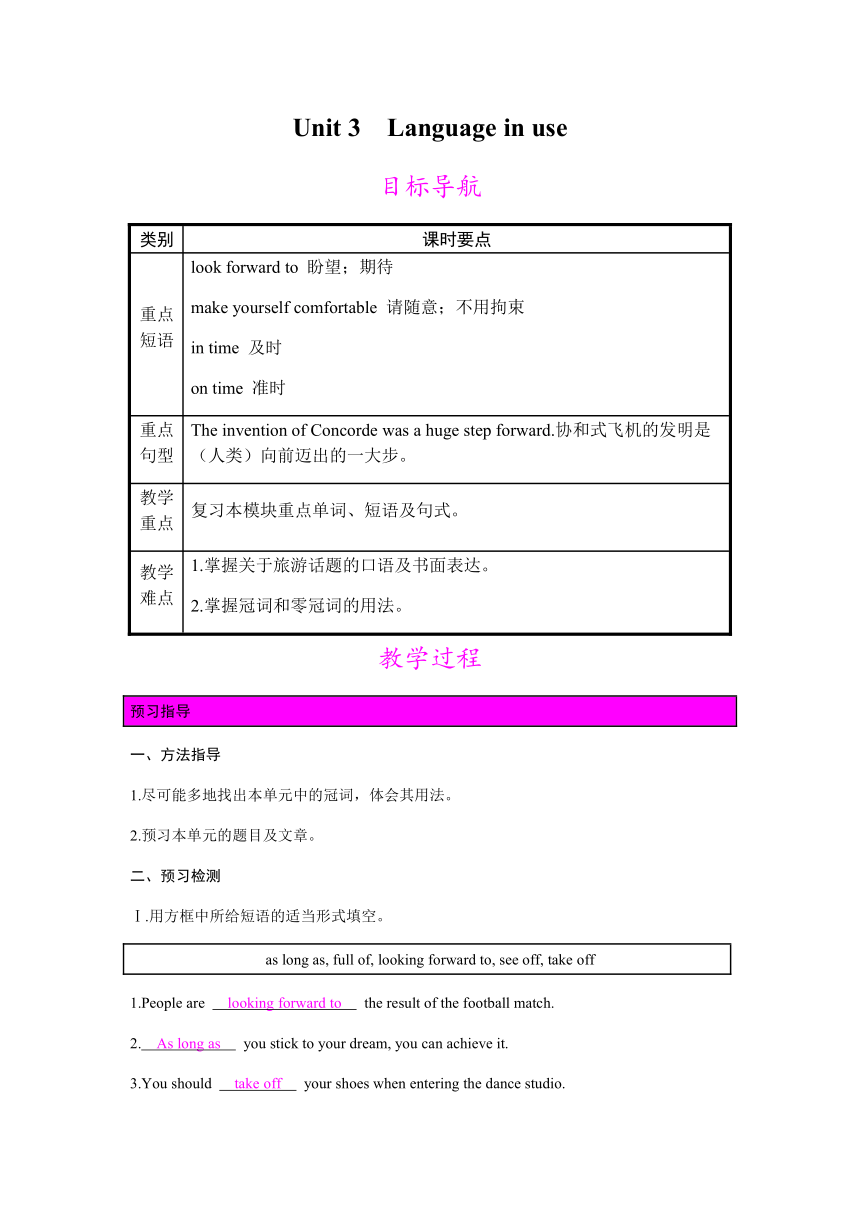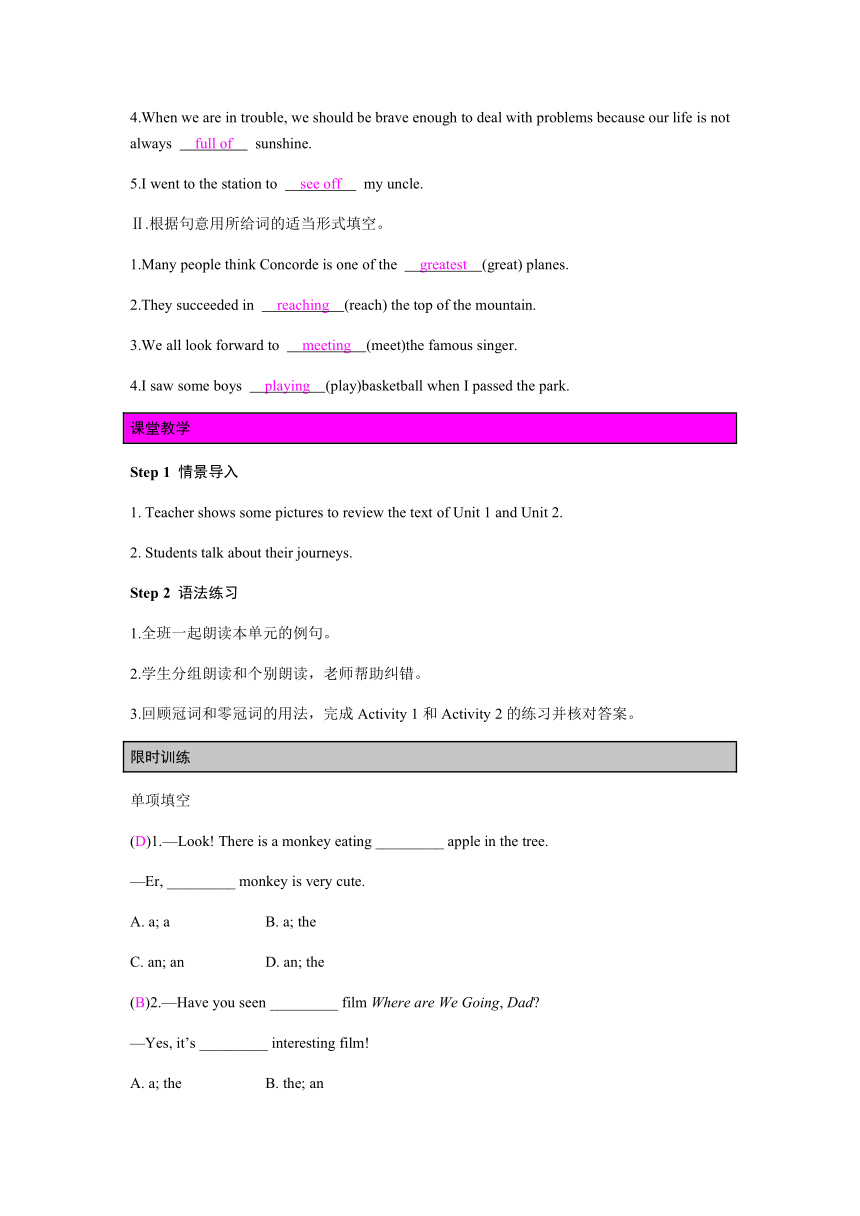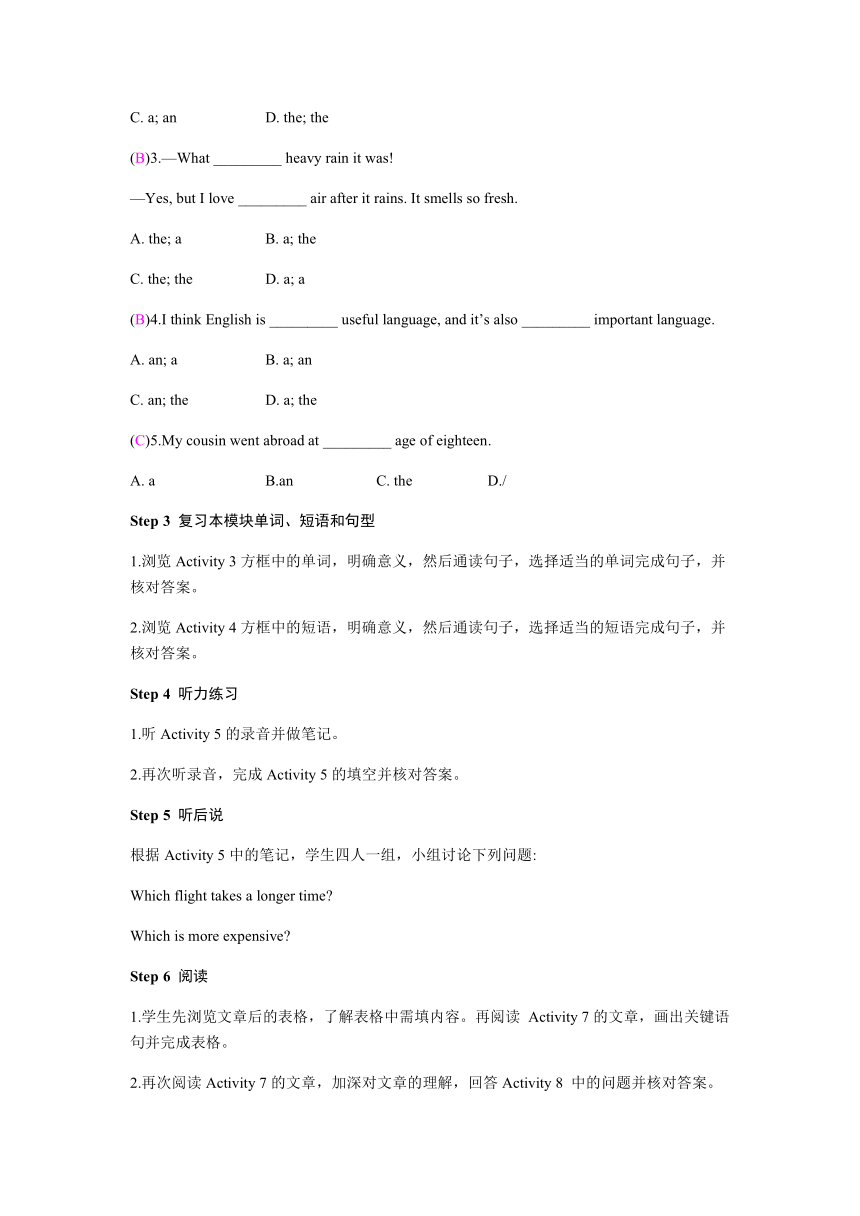Module 1 Travel Unit 3 Language in use外研社英语九年级下册教案(无答案)
文档属性
| 名称 | Module 1 Travel Unit 3 Language in use外研社英语九年级下册教案(无答案) |  | |
| 格式 | docx | ||
| 文件大小 | 25.1KB | ||
| 资源类型 | 教案 | ||
| 版本资源 | 外研版 | ||
| 科目 | 英语 | ||
| 更新时间 | 2023-03-04 17:03:48 | ||
图片预览



文档简介
Unit 3 Language in use
目标导航
类别 课时要点
重点短语 look forward to 盼望;期待 make yourself comfortable 请随意;不用拘束 in time 及时 on time 准时
重点句型 The invention of Concorde was a huge step forward.协和式飞机的发明是(人类)向前迈出的一大步。
教学重点 复习本模块重点单词、短语及句式。
教学难点 1.掌握关于旅游话题的口语及书面表达。 2.掌握冠词和零冠词的用法。
教学过程
预习指导
一、方法指导
1.尽可能多地找出本单元中的冠词,体会其用法。
2.预习本单元的题目及文章。
二、预习检测
Ⅰ.用方框中所给短语的适当形式填空。
as long as, full of, looking forward to, see off, take off
1.People are looking forward to the result of the football match.
2. As long as you stick to your dream, you can achieve it.
3.You should take off your shoes when entering the dance studio.
4.When we are in trouble, we should be brave enough to deal with problems because our life is not always full of sunshine.
5.I went to the station to see off my uncle.
Ⅱ.根据句意用所给词的适当形式填空。
1.Many people think Concorde is one of the greatest (great) planes.
2.They succeeded in reaching (reach) the top of the mountain.
3.We all look forward to meeting (meet)the famous singer.
4.I saw some boys playing (play)basketball when I passed the park.
课堂教学
Step 1 情景导入
1. Teacher shows some pictures to review the text of Unit 1 and Unit 2.
2. Students talk about their journeys.
Step 2 语法练习
1.全班一起朗读本单元的例句。
2.学生分组朗读和个别朗读,老师帮助纠错。
3.回顾冠词和零冠词的用法,完成Activity 1和Activity 2的练习并核对答案。
限时训练
单项填空
(D)1.—Look! There is a monkey eating _________ apple in the tree.
—Er, _________ monkey is very cute.
A. a; a B. a; the
C. an; an D. an; the
(B)2.—Have you seen _________ film Where are We Going, Dad
—Yes, it’s _________ interesting film!
A. a; the B. the; an
C. a; an D. the; the
(B)3.—What _________ heavy rain it was!
—Yes, but I love _________ air after it rains. It smells so fresh.
A. the; a B. a; the
C. the; the D. a; a
(B)4.I think English is _________ useful language, and it’s also _________ important language.
A. an; a B. a; an
C. an; the D. a; the
(C)5.My cousin went abroad at _________ age of eighteen.
A. a B.an C. the D./
Step 3 复习本模块单词、短语和句型
1.浏览Activity 3方框中的单词,明确意义,然后通读句子,选择适当的单词完成句子,并核对答案。
2.浏览Activity 4方框中的短语,明确意义,然后通读句子,选择适当的短语完成句子,并核对答案。
Step 4 听力练习
1.听Activity 5的录音并做笔记。
2.再次听录音,完成Activity 5的填空并核对答案。
Step 5 听后说
根据Activity 5中的笔记,学生四人一组,小组讨论下列问题:
Which flight takes a longer time
Which is more expensive
Step 6 阅读
1.学生先浏览文章后的表格,了解表格中需填内容。再阅读 Activity 7的文章,画出关键语句并完成表格。
2.再次阅读Activity 7的文章,加深对文章的理解,回答Activity 8 中的问题并核对答案。
Step 7 分组讨论
1.从以下几个方面与小组成员讨论你最近的旅游经历:
● how you travelled
● how long the journey took
● how you felt about it
2.学生写一篇关于自己旅行经历的文章。
Step 8 认识世界
1.阅读文章并回答下列问题:
(1)Who was the first pilot to fly alone across the Atlantic Ocean
Charles Lindbergh was the first pilot to fly alone across the Atlantic Ocean.
(2)When was his plane completed
It was completed in April,1927.
(3)What was the plane like
It was three metres high and weighed 975 kilos.
(4)Where did he take off in May 1927
He took off from New York.
(5)How long did he fly
He flew for about thirty-three hours.
2.小组内进行讨论,统一答案。
3.老师再与全班一起核对答案。
Step 9 模块任务:写短剧
1.小组合作。找一则关于好人好事的新闻故事,小组合作把它改编成一部短剧。注意确定好人物形象、地点、时间与情节。
2.编写短剧。
3.分配角色,排练短剧。
4.老师请1~2组学生课堂上展示,并及时给予点评。
板书设计
一、不定冠词的用法
an, a是不定冠词,仅用在可数名词单数前面,表示“一”的意义,但不强调数目。a用在以辅音音素开头的单词前,an用在以元音音素开头的单词前,如a boy, an elephant, a university, an hour等。
1.表示人或事物的某一类。例如:
A plane is a machine that can fly.飞机是一种会飞的机器。
2.表示某一类人或事物中的任何一个。例如:
This is an apple.这是一个苹果。
3.泛指某人或某物但不具体说明是何人何物。例如:
A man is waiting for you there.一个男人在那里等你。
4.表示“一个”的意思。例如:
My father will be back in a week.我爸爸一周后会回来。
5.表示“每”的意思。例如:
We have three meals a day.我们每天吃三顿饭。
6.用在可数名词单数前表示一类人或事物。例如:
The horse is a useful animal.马是一种有用的动物。
二、定冠词的基本用法
定冠词the与指示代词this, that同源,有“这(那)个”的意思,与名词连用,表示某个或某些特定的人或东西。
1.指谈话双方都知道的人或事物。例如:
Where is the teacher 老师在哪儿
2.复述上文提过的人或事物。例如:
I have a beautiful wallet, but the wallet was stolen yesterday.我有一个漂亮的钱包,但它昨天被偷了。
3.世界上独一无二的事物,如月亮、地球、天空、宇宙等。例如:
The sun rises in the east.太阳从东方升起。
4.用在方位名词前。
in the south 在南方
in the west 在西方
5.用在序数词或形容词最高级前。例如:
The first thing I want to say is to listen carefully in class.我想说的第一件事就是上课认真听讲。
6.表示两者间“较……的一个”时用定冠词。例如:
He is the taller of the two boys.他是这两个男孩中较高的一个。
7.用在形容词前,表示一类人或东西。例如:
the rich 富人
the poor 穷人
the deaf 聋人
the wounded 伤员
8.用在姓氏的复数形式前表示一家人。例如:
The Browns went to Beijing last Sunday.布朗一家人上周去了北京。
9.在演奏西洋乐器前加the。例如:
play the piano 弹钢琴
play the violin 拉小提琴
10.在习惯性短语中。例如:
in the morning 早晨
in the afternoon下午
11.在人或物后有限定性的后置定语。例如:
The man standing by the gate is Tom’s father.站在门口的男人是汤姆的爸爸。
12.在世纪、年代名词前用冠词。例如:
in the 1980s/in the 1980’s 20世纪80年代
in the nineteenth century 19世纪
三、零冠词
1.在物质名词,抽象名词前不用冠词。例如:
It is made of wood. 它由木头制成。
2.专有名词前不加冠词。
3.名词前有物主代词、指示代词、不定代词、名词所有格修饰时。
4.月份、星期、季节前不用冠词。
5.在表示一类人或事物的复数名词前不用冠词。例如:
My mother and father are school teachers. 我父母是学校老师。
6.在breakfast, lunch, supper三餐前不用冠词。如果这些词前有形容词修饰可用不定冠词。例如:
I have breakfast at seven every day. 我每天7点吃早饭。
I had a good lunch yesterday. 昨天,我吃了一顿丰盛的午餐。
7.在球类、棋类名词前不用冠词。例如:
He often plays football after school. 放学后他常去踢足球。
教学反思
本节课的语法重点是冠词和零冠词的用法。课堂效果需要做大量的习题巩固,也需要学生反复记忆。老师应该提供精准的习题,安排习题课,让学生在练习中总结归纳冠词的用法,牢固地掌握该语法点。对于底子薄或性格内向的学生,降低他们的学习标准,对学生取得的进步及时给予鼓励,增强学生学习英语的兴趣。
目标导航
类别 课时要点
重点短语 look forward to 盼望;期待 make yourself comfortable 请随意;不用拘束 in time 及时 on time 准时
重点句型 The invention of Concorde was a huge step forward.协和式飞机的发明是(人类)向前迈出的一大步。
教学重点 复习本模块重点单词、短语及句式。
教学难点 1.掌握关于旅游话题的口语及书面表达。 2.掌握冠词和零冠词的用法。
教学过程
预习指导
一、方法指导
1.尽可能多地找出本单元中的冠词,体会其用法。
2.预习本单元的题目及文章。
二、预习检测
Ⅰ.用方框中所给短语的适当形式填空。
as long as, full of, looking forward to, see off, take off
1.People are looking forward to the result of the football match.
2. As long as you stick to your dream, you can achieve it.
3.You should take off your shoes when entering the dance studio.
4.When we are in trouble, we should be brave enough to deal with problems because our life is not always full of sunshine.
5.I went to the station to see off my uncle.
Ⅱ.根据句意用所给词的适当形式填空。
1.Many people think Concorde is one of the greatest (great) planes.
2.They succeeded in reaching (reach) the top of the mountain.
3.We all look forward to meeting (meet)the famous singer.
4.I saw some boys playing (play)basketball when I passed the park.
课堂教学
Step 1 情景导入
1. Teacher shows some pictures to review the text of Unit 1 and Unit 2.
2. Students talk about their journeys.
Step 2 语法练习
1.全班一起朗读本单元的例句。
2.学生分组朗读和个别朗读,老师帮助纠错。
3.回顾冠词和零冠词的用法,完成Activity 1和Activity 2的练习并核对答案。
限时训练
单项填空
(D)1.—Look! There is a monkey eating _________ apple in the tree.
—Er, _________ monkey is very cute.
A. a; a B. a; the
C. an; an D. an; the
(B)2.—Have you seen _________ film Where are We Going, Dad
—Yes, it’s _________ interesting film!
A. a; the B. the; an
C. a; an D. the; the
(B)3.—What _________ heavy rain it was!
—Yes, but I love _________ air after it rains. It smells so fresh.
A. the; a B. a; the
C. the; the D. a; a
(B)4.I think English is _________ useful language, and it’s also _________ important language.
A. an; a B. a; an
C. an; the D. a; the
(C)5.My cousin went abroad at _________ age of eighteen.
A. a B.an C. the D./
Step 3 复习本模块单词、短语和句型
1.浏览Activity 3方框中的单词,明确意义,然后通读句子,选择适当的单词完成句子,并核对答案。
2.浏览Activity 4方框中的短语,明确意义,然后通读句子,选择适当的短语完成句子,并核对答案。
Step 4 听力练习
1.听Activity 5的录音并做笔记。
2.再次听录音,完成Activity 5的填空并核对答案。
Step 5 听后说
根据Activity 5中的笔记,学生四人一组,小组讨论下列问题:
Which flight takes a longer time
Which is more expensive
Step 6 阅读
1.学生先浏览文章后的表格,了解表格中需填内容。再阅读 Activity 7的文章,画出关键语句并完成表格。
2.再次阅读Activity 7的文章,加深对文章的理解,回答Activity 8 中的问题并核对答案。
Step 7 分组讨论
1.从以下几个方面与小组成员讨论你最近的旅游经历:
● how you travelled
● how long the journey took
● how you felt about it
2.学生写一篇关于自己旅行经历的文章。
Step 8 认识世界
1.阅读文章并回答下列问题:
(1)Who was the first pilot to fly alone across the Atlantic Ocean
Charles Lindbergh was the first pilot to fly alone across the Atlantic Ocean.
(2)When was his plane completed
It was completed in April,1927.
(3)What was the plane like
It was three metres high and weighed 975 kilos.
(4)Where did he take off in May 1927
He took off from New York.
(5)How long did he fly
He flew for about thirty-three hours.
2.小组内进行讨论,统一答案。
3.老师再与全班一起核对答案。
Step 9 模块任务:写短剧
1.小组合作。找一则关于好人好事的新闻故事,小组合作把它改编成一部短剧。注意确定好人物形象、地点、时间与情节。
2.编写短剧。
3.分配角色,排练短剧。
4.老师请1~2组学生课堂上展示,并及时给予点评。
板书设计
一、不定冠词的用法
an, a是不定冠词,仅用在可数名词单数前面,表示“一”的意义,但不强调数目。a用在以辅音音素开头的单词前,an用在以元音音素开头的单词前,如a boy, an elephant, a university, an hour等。
1.表示人或事物的某一类。例如:
A plane is a machine that can fly.飞机是一种会飞的机器。
2.表示某一类人或事物中的任何一个。例如:
This is an apple.这是一个苹果。
3.泛指某人或某物但不具体说明是何人何物。例如:
A man is waiting for you there.一个男人在那里等你。
4.表示“一个”的意思。例如:
My father will be back in a week.我爸爸一周后会回来。
5.表示“每”的意思。例如:
We have three meals a day.我们每天吃三顿饭。
6.用在可数名词单数前表示一类人或事物。例如:
The horse is a useful animal.马是一种有用的动物。
二、定冠词的基本用法
定冠词the与指示代词this, that同源,有“这(那)个”的意思,与名词连用,表示某个或某些特定的人或东西。
1.指谈话双方都知道的人或事物。例如:
Where is the teacher 老师在哪儿
2.复述上文提过的人或事物。例如:
I have a beautiful wallet, but the wallet was stolen yesterday.我有一个漂亮的钱包,但它昨天被偷了。
3.世界上独一无二的事物,如月亮、地球、天空、宇宙等。例如:
The sun rises in the east.太阳从东方升起。
4.用在方位名词前。
in the south 在南方
in the west 在西方
5.用在序数词或形容词最高级前。例如:
The first thing I want to say is to listen carefully in class.我想说的第一件事就是上课认真听讲。
6.表示两者间“较……的一个”时用定冠词。例如:
He is the taller of the two boys.他是这两个男孩中较高的一个。
7.用在形容词前,表示一类人或东西。例如:
the rich 富人
the poor 穷人
the deaf 聋人
the wounded 伤员
8.用在姓氏的复数形式前表示一家人。例如:
The Browns went to Beijing last Sunday.布朗一家人上周去了北京。
9.在演奏西洋乐器前加the。例如:
play the piano 弹钢琴
play the violin 拉小提琴
10.在习惯性短语中。例如:
in the morning 早晨
in the afternoon下午
11.在人或物后有限定性的后置定语。例如:
The man standing by the gate is Tom’s father.站在门口的男人是汤姆的爸爸。
12.在世纪、年代名词前用冠词。例如:
in the 1980s/in the 1980’s 20世纪80年代
in the nineteenth century 19世纪
三、零冠词
1.在物质名词,抽象名词前不用冠词。例如:
It is made of wood. 它由木头制成。
2.专有名词前不加冠词。
3.名词前有物主代词、指示代词、不定代词、名词所有格修饰时。
4.月份、星期、季节前不用冠词。
5.在表示一类人或事物的复数名词前不用冠词。例如:
My mother and father are school teachers. 我父母是学校老师。
6.在breakfast, lunch, supper三餐前不用冠词。如果这些词前有形容词修饰可用不定冠词。例如:
I have breakfast at seven every day. 我每天7点吃早饭。
I had a good lunch yesterday. 昨天,我吃了一顿丰盛的午餐。
7.在球类、棋类名词前不用冠词。例如:
He often plays football after school. 放学后他常去踢足球。
教学反思
本节课的语法重点是冠词和零冠词的用法。课堂效果需要做大量的习题巩固,也需要学生反复记忆。老师应该提供精准的习题,安排习题课,让学生在练习中总结归纳冠词的用法,牢固地掌握该语法点。对于底子薄或性格内向的学生,降低他们的学习标准,对学生取得的进步及时给予鼓励,增强学生学习英语的兴趣。
同课章节目录
- Module 1 Travel
- Unit 1 We toured the city by bus and by taxi
- Unit 2 It's a long story.
- Unit 3 Language in use
- Module 2 Education
- Unit 1 They don't sit in rows.
- Unit 2 What do I like best about school?
- Unit 3 Language in use
- Module 3 Life now and then
- Unit 1 They sometimes work harder.
- Unit 2 I think life is better today.
- Unit 3 Language in use.
- Module 4 Rules and suggestions
- Unit 1 You must be careful of falling stones.
- Unit 2 we must keep the camp clean.
- Unit 3 Language in use.
- Revison A
- Module 5 Look after yourself
- Unit 1 We'd better get you to hospital.
- Unit 2 Get off the sofa!
- Unit 3 Language in use.
- Module 6 Eating togethe
- Unit 1 When is the school-leavers' party?
- Unit 2 Knives and forks are used for most Western
- Unit 3 Language in use
- Module 7 English for you and me
- Unit 1 Have you ever been to an English corner?
- Unit 2 We all own English.
- Unit 3 Language in use
- Module 8 My future life
- Unit 1 Here's to our friendship and the future
- Unit 2 I know that you will be better at maths.
- Unit 3 Language in use
- Revison B
